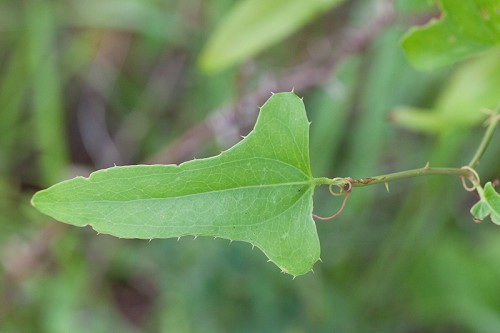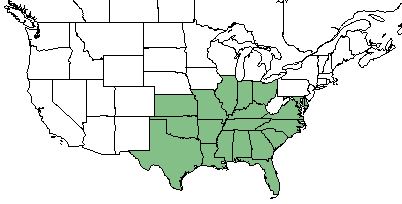Difference between revisions of "Smilax bona-nox"
(→Ecology) |
|||
| Line 1: | Line 1: | ||
{{italic title}} | {{italic title}} | ||
| + | Common Names: Saw Greenbrier <ref name= "USDA"> [https://plants.usda.gov/core/profile?symbol=CEAM USDA Plant Database]</ref> | ||
<!-- Get the taxonomy information from the NRCS Plants database --> | <!-- Get the taxonomy information from the NRCS Plants database --> | ||
{{taxobox | {{taxobox | ||
Revision as of 13:53, 7 June 2018
Common Names: Saw Greenbrier [1]
| Smilax bona-nox | |
|---|---|

| |
| Photo by John Gwaltney hosted at Southeastern Flora.com | |
| Scientific classification | |
| Kingdom: | Plantae |
| Division: | Magnoliophyta - Flowering plants |
| Class: | Liliopsida - Moncots |
| Order: | Liliales |
| Family: | Smilacaceae |
| Genus: | Smilax |
| Species: | S. bona-nox |
| Binomial name | |
| Smilax bona-nox L. | |

| |
| Natural range of Smilax bona-nox from USDA NRCS Plants Database. | |
Contents
Taxonomic Notes
Synonym: S. bona-nox var. exauriculata (Fernald), S. bona-nox var. hederifolia (Beyrich) Fernald
Variety: S. bona-nox var. littoralis (Coker ex Sorrie)
Description
S. bona-nox is a perennial shrub/vine of the Smilacaceae family that is native to North America. [1]
Distribution
S. bona-nox is found in the southeastern United States; Florida, Georgia, South Carolina, North Carolina, Virginia, Maryland, Delaware, Ohio, Indiana, Kentucky, Tennessee, Illinois, Alabama, Missouri, Arkansas, Mississippi, Louisiana, Oklahoma, Kansas, and Texas.[1]
Ecology
Habitat
Common habitats for S. bona-nox include wetland and upland habitats, dunes, and maritime thickets and forests. [2]
S. bona-nox can grow in a variety of soils, coarse, medium, and fine textures.[1]
It has a medium tolerance to drought and a high tolerance for shade. [1]
Phenology
Flowering occurs in April. [3]
Fire ecology
S. bona-nox has a high tolerance to fire. [1]